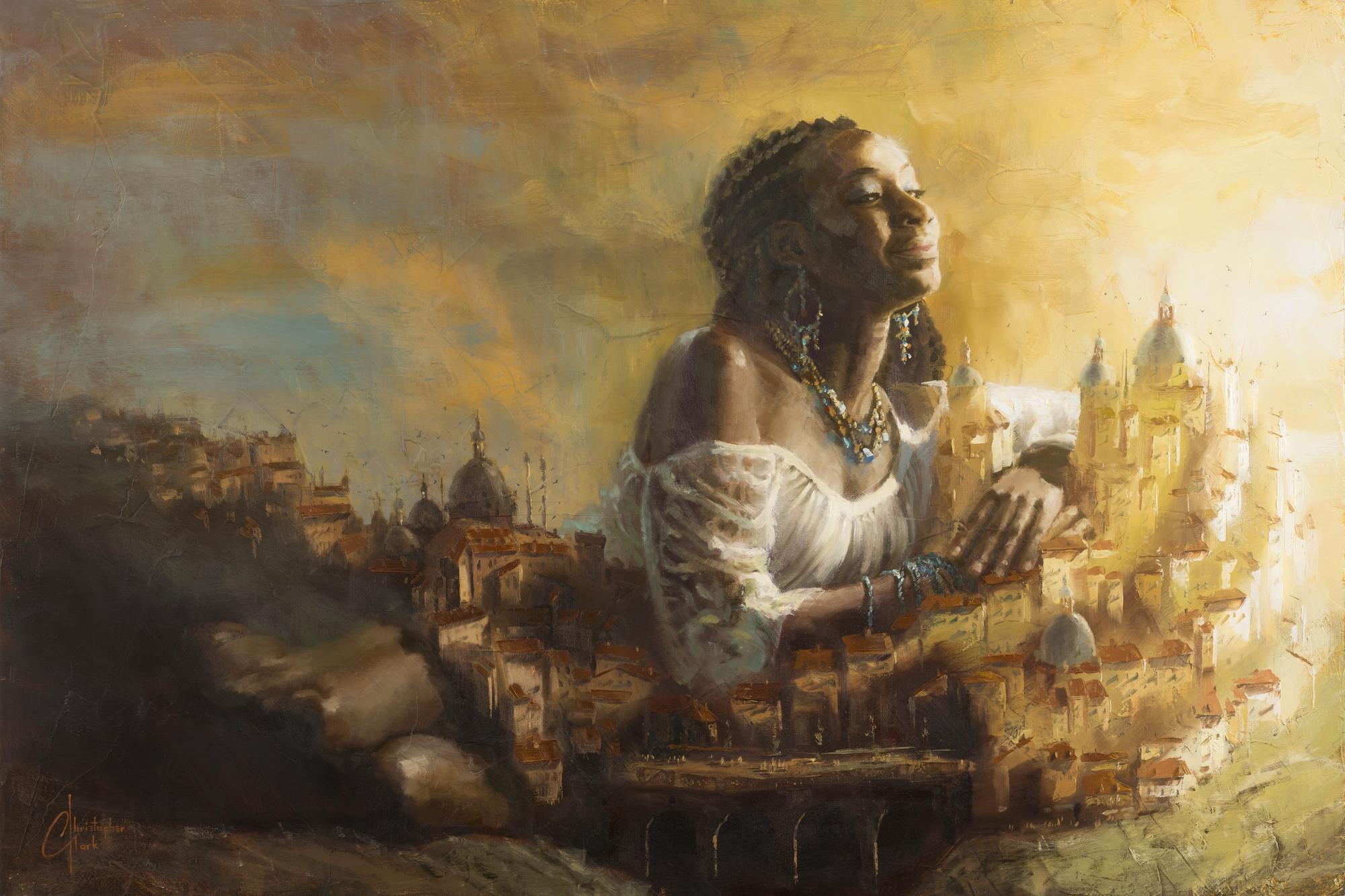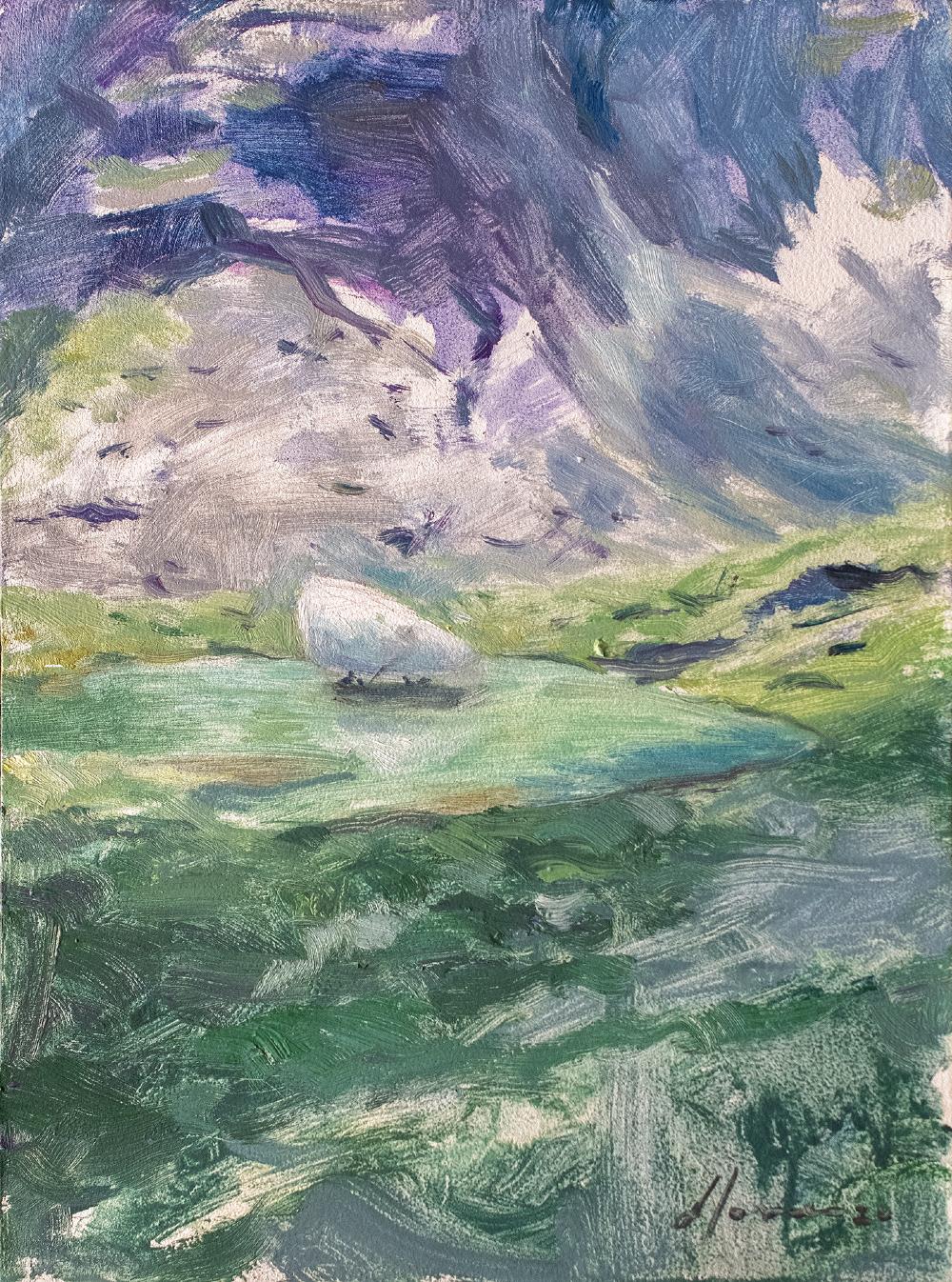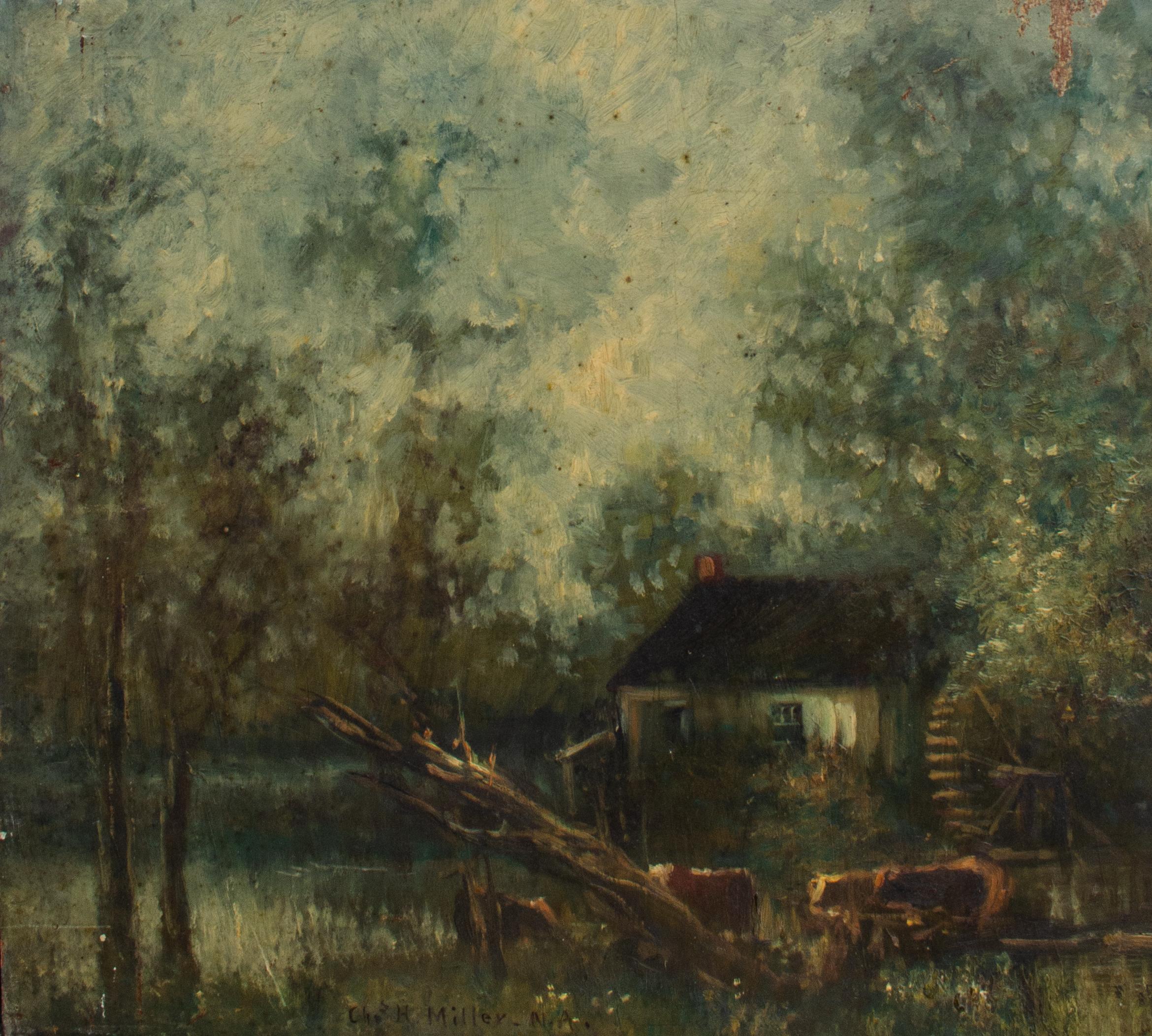Items Similar to "Great Kills, Staten Island" Dry Docks in Winter, Snowy Impressionist Landscape
Want more images or videos?
Request additional images or videos from the seller
1 of 8
William Jean Beauley"Great Kills, Staten Island" Dry Docks in Winter, Snowy Impressionist Landscapecirca 1917
circa 1917
About the Item
William Jean Beauley
Great Kills, circa 1917
Signed lower right
Oil on panel
40 x 50 inches
Housed in its original Newcomb-Macklin gilt frame
Provenance:
The artist
Henry Reinhardt and Son
R.H. Love Galleries, Chicago
Private Collection, Ohio
Exhibited:
Philadelphia, Pennsylvania Academy of Fine Arts, February 4 - March 25, 1917, no. 302.
Art Institute of Chicago, Annual American exhibition [of] paintings and sculpture, 1918, no. 15.
New York, Henry Reinhardt and Son.
Chicago, R.H. Love Galleries, A Selection of American Paintings, 1977, p. 60, illustrated.
Literature:
Fine Arts Journal, “An Exponent of Truly American Art,” Vol. 36, No. 4, Apr., 1918, pp. 26-33, illustrated.
"Another splendid canvas is Great Kills which glows with a beauty, that would make the reputation of any man as a colorist. The sunlight on the snow is so magically convincing and to observe at close range the broad white splashes with which this effect has been achieved is to realize the meaning of the word genius. There is nothing else that can be mixed with paint which would account for this phenomenon."
- Fine Arts Journal, 1918
Born in Joliet, Illinois, William Beauley became a New York City architect and artist. He began his career in Chicago, working for several architects in the early 1890s for the World's Fair. After the Fair, Beauley studied in France under Maurice Yvon, architect of the French government.
In Paris, he associated with painters, and began sketching with them, which led to a life-long interest in painting. In New York, he studied at the Chase School with Robert Henri. He was a member of the Architectural League of New York (where he also won an award for his artwork in 1912), the Salmagundi Club, the American Art Association of Paris and the Philadelphia Art Club. During the New Deal in the 1930s, he was registered as a WPA artist. Two of his paintings are in the collection of the Smithsonian’s National Museum of American Art.
- Creator:William Jean Beauley (1874 - 1937)
- Creation Year:circa 1917
- Dimensions:Height: 52 in (132.08 cm)Width: 62 in (157.48 cm)
- Medium:
- Movement & Style:
- Period:
- Condition:
- Gallery Location:New York, NY
- Reference Number:1stDibs: LU1841211728802
About the Seller
5.0
Platinum Seller
These expertly vetted sellers are 1stDibs' most experienced sellers and are rated highest by our customers.
Established in 2021
1stDibs seller since 2022
59 sales on 1stDibs
Typical response time: 1 hour
- ShippingRetrieving quote...Ships From: New York, NY
- Return PolicyA return for this item may be initiated within 3 days of delivery.
More From This SellerView All
- "Parisian Nocturne, France, " Frank Edwin Scott, American ImpressionismBy Frank Edwin ScottLocated in New York, NYEdwin Frank Scott (1863 - 1929) Parisian Noctune, France Oil on woof panel 8 1/4 x 10 1/2 inches Signed lower left Born in Buffalo, New York, Edwin Frank ...Category
Late 19th Century American Impressionist Landscape Paintings
MaterialsOil, Wood Panel
- "On the Beach, " Nicolai Cikovsky, American Impressionism, Landscape SeascapeBy Nicolai CikovskyLocated in New York, NYNicolai S. Cikovsky (1894 - 1984) On the Beach Oil on panel 15 1/4 x 20 inches Signed lower right Provenance: ACA Galleries, New YorkCategory
Mid-20th Century American Impressionist Landscape Paintings
MaterialsOil, Panel
- "MacMahan's Maine, " Howard Everett Giles, Figurative Landscape, ImpressionismLocated in New York, NYHoward Everett Giles (1876 - 1955) MacMahan's Maine Oil on canvas backed with board 30 x 30 inches Signed lower right Provenance: Art Institute of Chicago Christie's New York, December 8, 2011, Lot 2 Howard Giles spent most of his career in New York City, where he was an educator, magazine illustrator, and painter who espoused the theory of Dynamic Symmetry. He was born in Brooklyn, and as a young man worked in a New York railroad office. Financial support of a family friend allowed him to study at the Art Students League with H. Siddons Mowbray. In early 1910, he became an illustrator for Scribner's Magazine, and in 1912, on sketching assignment for Scribner's went to England. During World War I, he did illustration for Harper's Monthly Magazine, and many of his images were 'roaring twenties' genre and figure paintings. In 1912, he began teaching life classes at the New York School of Fine and Applied Arts (later Parsons School of Design), and remained there until the late 1920s. During that time, he was also a part-time instructor at the Childs-Walker School in Boston, and accepted numerous invitations to lecture including at Carnegie Institute in Pittsburgh, Pennsylvania Academy of the Fine Arts, Detroit Institute of Arts and Wellesley College. His initial painting style was Impressionism, but he grew increasingly interested in other scientific, aesthetic theories. He worked with Jay Hambridge from 1916 to 1919, applying Hambridge's theory of Dynamic Symmetry to his painting and his lecture topics. From 1922 to 1926, Giles also worked with and was influenced in his own painting by colorist theorist Denman Ross, who espoused a limited and related color palette. For many of his paintings, Giles used watercolor although he also painted in oil and pastels. During the last years before his retirement when he moved to Woodstock...Category
Early 20th Century American Impressionist Landscape Paintings
MaterialsOil, Panel
- "Nantucket, Massachusetts" Helen Goodwin, American Impressionism Docks at HarborLocated in New York, NYHelen M. Goodwin (1865 - 1955) Nantucket, Massachusetts Oil on canvas laid on panel 12 x 16 inches Signed and titled lower right Helen M. Goodwin was born in New Castle, Indiana in ...Category
Early 20th Century American Impressionist Landscape Paintings
MaterialsOil, Panel, Canvas
- "Summer Landscape, " Joseph DeCamp, Boston Ten American ImpressionistsBy Joseph Rodefer DeCampLocated in New York, NYJoseph Rodefer DeCamp (1858 - 1923) Summer Landscape Oil on board 11 x 15 inches Signed lower right Born in Cincinnati, Ohio on November 5, 1858, Joseph DeCamp began his artistic career in his teens and remained active throughout his life. Although he initially painted landscapes, Decamp became a renowned and respected portraitist. He was famous for his images of men of high society and women within domestic interiors. Decamp began his artistic training in 1873 when he enrolled in the McMicken School of Art and Design in Cincinnati. The head of the school, Thomas Satterwhite Noble, was a European-trained painter whose "insistence on rigorous draftsmanship, true to the academic manner in which he had been trained, exerted a lasting influence on DeCamp." DeCamp studied under Noble for five years, but was also a student of Frank Duveneck at the Ohio Mechanics Institute. He adopted Duveneck's bold, realistic style and many of his paintings executed throughout the 1870s and 1880s reflect this influence. Like most American artists of his generation, DeCamp went abroad to study. In 1878, following in the footsteps of Duveneck and other Midwesterners, he traveled to Munich to attend the Royal Bavarian Academy. Soon after his arrival, however, he gravitated away from the academy and towards Duveneck and eventually followed his mentor to Florence and Venice. During these years, DeCamp focused on landscape and portraiture as his primary subjects. These themes would continue to occupy the artist when he returned to America in 1883. When DeCamp arrived back in the United States in 1883, he first settled in Cincinnati, but soon moved to Cleveland to teach at what is now Case Western Reserve University. He then relocated once more to the Boston area, where he would remain for most of his life. DeCamp began teaching at Wellesley Female Academy and, in the fall of 1885, began as an instructor at the School of Drawing and Painting at the Museum of Fine Arts in Boston. He quickly established himself as one of the leading figures in the Boston art community and became a founding member of The Ten American Painters, formulated in 1897. This group included Childe Hassam, John Henry Twachtman, Julian Alden Weir, Frank Benson, Thomas Dewing, Willard Metcalf, Robert Reid, Edward Simmons...Category
19th Century American Impressionist Landscape Paintings
MaterialsPanel, Oil
- "Concarneau, Brittany, France" Hayley Lever, American ImpressionismBy Hayley LeverLocated in New York, NYHayley Lever (1876 - 1958) Concarneau, Brittany, France, 1905 Oil on panel 6 3/4 x 9 1/2 inches Signed by the artist lower left Inscribed by another hand on the reverse Provenance: Clayton-Liberatore Galleries, Bridgehampton, New York Hayley Lever’s (1875-1958) versatility has worked against his posthumous reputation. He was never associated with a single artistic movement, instead producing impressionist, post-impressionist, and expressionist works. While best known as a painter of post-impressionist marine scenes, his subject matter included landscapes, urban scenes, and still lifes across his 60-year career. This lack of a singular style or subject has given him an amorphous place in U.S. art history despite his obvious accomplishments. [Richard] Hayley Lever was born in Bowden, South Australia in 1875. He excelled in painting classes at Prince Alfred College (1883-91) and Norwood Art School (1891-93) in Adelaide. In the 1890s, Lever moved to England, studying art in London and painting at St. Ives, a fishing port and popular artistic colony on the Cornish coast. In St. Ives, Lever shared a studio with Frederick Waugh, and studied painting with Albert Julius Olsson and Algernon Talmage. Lever was a plein air painter particularly interested in the effect of sunlight on the sea. He painted in a distinctive style, strongly influenced by the works of Vincent van Gogh, that might now be called post-impressionism. He used a limited palette to paint the St. Ives harbor, particularly at dusk or in the moonlight. His strong contrasting colors and thick use of paint created a crisp and physical surface that earned him acclaim in Europe. Lever’s many St. Ives seascapes are among his most popular works. In 2017, his painting entitled “The Old Lighthouse and Fleets of St. Ives” sold at auction for $162,500. In 1912, Lever moved to New York to test the art market in the United States. In Manhattan, Lever met prominent U.S. painters such as Ernest Lawson, Robert Henri, William Glackens, John Sloan, and George Bellows. Lever exhibited with this group regularly in New York City, painting parks, streets, bridges and the Manhattan waterfront. However, he soon discovered the scenic potential of Gloucester, Rockport, and Marblehead in the Cape Ann area of Massachusetts...Category
Early 1900s American Impressionist Landscape Paintings
MaterialsOil, Panel
You May Also Like
- Cradle of CivilizationBy Christopher Clark 1Located in Denver, COLone figure with cityCategory
2010s American Impressionist Figurative Paintings
MaterialsOil, Wood Panel
- The Sailor is a 11 x 8" oil Cuban-American Water ImpressionismBy Reynier LlanesLocated in Houston, TXREDUCED FROM $3000 The Sailor is a 11 x 8" oil painting by Cuban-American artist Reynier Llanes who lives in Miami. It is framed. It is oil painted on a wood panel . The Sailor floats in the frame. The background of Reynier Llanes is unique in style , subject matter, and medium. The artist says this about Field of Flight The characters in my paintings emerge from stories and their journeys are inspired by my own experiences and daily routines. My inspiration comes from literature, music, cinema, and daily life. My daily routine enables me to meditate and use my creativity to serve these stories and inspirations. I begin my mornings with sketches and watercolors. This is the time I use to keep inventory of my ideas and to allow them to further inspire me. Many of these characters have been depicted in my work before, whether in a different geographical location or in a different state of their physical evolution. I use a variety of mediums in my work including oils, watercolors, coffee, and charcoal. They are all equally important to me as they allow me full expression, each in its’ own sector. I use a great deal of symbolism in my art to give depth to the subjects that I wish to express. I want my art to tell a story in a manner that stimulates the imaginations of others, especially of things never seen or expressed directly. As an observer it is clear to see that we are all in pursuit of life’s mission of working, loving, and belonging. I begin my paintings by building layers of textures and color values, and then subtly add dimension and depth. Through the use of colors and highlighting I am able to enhance the atmosphere with mood, character, depth and mystery, and bring special attention to my subjects. It is the creative process of using these materials and methods that feed my soul, life, and being. I believe it is our mission as intellectuals to have a voice in our society, for our work to have a footprint in history, and to be a reference for future generations. BIO: Reynier Llanes was born in Pinar del Rio, Cuba in 1985. He attended the city’s school of art (Instructores de Arte) for four years and completed his studies in 2004. Llanes was tutored by one of the country’s most recognized realist artists, Juan Miguel Suárez. In 2005 he moved to Havana where he continued his studies and collaborated with various artists. The capital was a thriving mecca of art and culture and the museums the grounds for inspiration. In 2007 LIanes availed himself of an opportunity to emigrate from Cuba and moved to the United States, first settling in Naples, FL. In Naples he began to introduce his work in a major exhibition entitled “Strange Visitor” at the Kapo Maestro Gallery. In 2009 he relocated to Charleston, SC where he had the honor of being granted an artist in residency at the Jonathan Green Studios. Llanes was awarded a "first purchase award" for a piece now in the art collection of the city of Charleston 2011 at Moja Art Festival Juried Exhibition Award. In 2012 Oxford America recognized him as one of the "New Superstars of Southern Art." The art of Reynier was nourished by the rich southern culture and he began to collaborate with various museums and art centers. His work was featured in a traveling exhibition The Vibrant Vision Collection at the Morris Museum in Augusta, GA and the Gibbes Museum of Art in Charleston, SC. Llanes is also an avid art collector in his own right, focusing on works by artists from Cuba, and particularly those from his native province of Pinar del Río. A selection of works from his collection was exhibited at City Gallery in Charleston in 2013 and in the Art Museum in Myrtle Beach in 2015. In 2015 Llanes relocated with his family to Miami in order to take advantage of the city’s international art market and vibrant cultural life and to be closer to his home country. South Florida is, of course, home to a large community of intellectuals, collectors, and fellow artists who have welcomed Llanes into their cosmopolitan scene. His first solo exhibition in Miami took place at Miami Dade College West, this exhibition was entitled “Preserving Cultural Heritage” and it featured a large collection of coffee paintings. In 2017 he met Bill Meek...Category
2010s American Impressionist Landscape Paintings
MaterialsWood Panel, Oil
- Glen Rose Abstract Expressionism, Oil on Canvas, TX Artist Floral ColorsLocated in Houston, TXLOOK FOR FREE SHIPPING AT CHECKOUT OR GALLERY DISCOUNT Glen Rose displays bold and bright colors to highlight this abstract landscape piece of art by Texas artist Charlotte Seifert G...Category
2010s American Impressionist Abstract Paintings
MaterialsOil, Wood Panel
- Cozy Country Cabin by Long Island Artist C.H. MillerBy Charles Henry MillerLocated in Larchmont, NYCharles Henry Miller (American, 1842-1922) Untitled (Country Cabin), c. late 1800s-early 1900s Oil on wood panel 18 x 19 1/2 in. Signed bottom: Chas. H. Miller, N.A. Charles Henry Miller was a noted artist and painter of landscapes from Long Island, New York. The American poet Bayard Taylor called him, "The artistic discoverer of the little continent of Long Island." Miller was educated at Mount Washington Collegiate Institute, and graduated in medicine at the New York Homeopathic Institute in 1864. Before his graduation, he had occasionally painted pictures, and in 1860 he exhibited The Challenge Accepted at the National Academy of Design, in New York City. He lived in Queens at the summer estate, Queenslawn, originally purchased by his parents. He went abroad in 1864 and again in 1867, and was a pupil in the Bavarian Royal Academy at Munich under the instruction of Adolf Lier...Category
Early 20th Century American Impressionist Landscape Paintings
MaterialsWood Panel, Oil
- Koh Nee Noh at Dock SketchBy Thomas CardoneLocated in Sag Harbor, NYKoh Nee Noh at Dock Sketch was painted en plein-air, in Greenport Harbor, NY. A motley of colors in horizontal lines create the reflective waters surface. A Sailboat rests at a dock,...Category
21st Century and Contemporary American Impressionist Landscape Paintings
MaterialsOil, Wood Panel
- Vendemmia No. 2By Marc DalessioLocated in Sag Harbor, NYVendemmia No. 2 illustrates a beautiful sunny day on a vineyard in Tuscany. A master of plein-air painting, Dalessio paints the wind, with evidence in the fast-moving cumulus clouds,...Category
21st Century and Contemporary American Impressionist Landscape Paintings
MaterialsOil, Wood Panel
Recently Viewed
View AllMore Ways To Browse
Illustrated Gallery
Winter In France
Dries 40
Chicago Antique
Landscape Architect
Long Island Oil
Winter In Paris
Long Island Landscape
Impressionist Winter
Impressionist Winter Landscape
Winter Landscape Impressionist Paintings
American Impressionist Chicago
Illinois Landscape
The Great Chase
Philadelphia Love
P 60
Painting Woods In Winter
Paris Painting Winter




